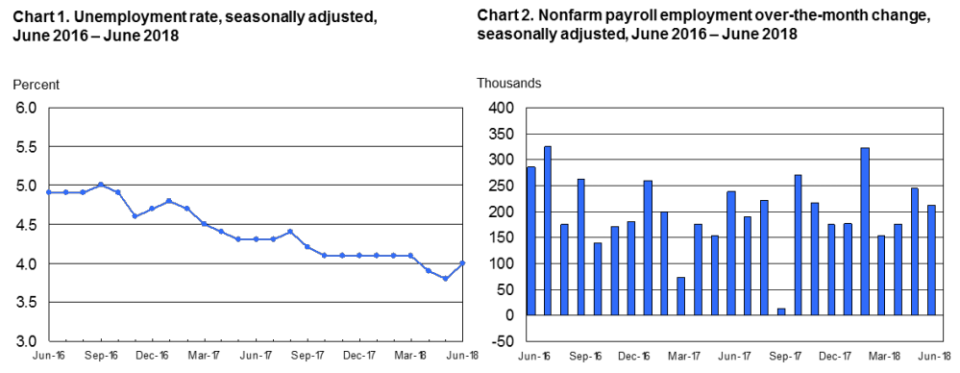U.S. economy adds more jobs than expected in June
The June jobs report is out and it’s a beat.
The U.S. economy added 213,000 jobs in June while the unemployment rate rose to 4%, according to the latest figures from the Bureau of Labor Statistics.
May’s job gains were also revised up to 244,000 from 223,000, and job gains have now averaged 211,000 per month over the last three months.
Economists had forecast that June would be another strong month for the U.S. labor market, with nonfarm payrolls expected to have grown by 195,000 during the month with the unemployment rate expected to hold steady at an 18-year low of 3.8%, according to estimates compiled by Bloomberg.

The big story in Friday’s report, however, was the increase in labor force participation, which rose from 62.7% in May to 62.9% in June. This uptick in people joining the workforce — there were 601,000 new entrants to the labor force in June — pushed up the unemployment rate.
Wages were a bit of a disappointment in Friday’s report, with average hourly earnings rising by 0.2% over the prior month and 2.7% over the prior year.
Wages were being carefully watched by economists for signs of inflationary pressures building in the economy, with average hourly earnings forecast to have risen 0.3% over last month in June and 2.8% over the same month last year.
The increased participation combined with a lack of accelerating wage growth during June indicates a labor market that still has enough slack remaining to pull in new workers who had been disengaged from the workforce.
“The solid 213,000 gain in non-farm payrolls in June, which followed an even stronger 244,000 rise in May, illustrates that labor market conditions remain unusually strong,” said Andrew Hunter, U.S. economist at Capital Economics.
“Together with signs that GDP growth rebounded markedly in the second quarter, that will keep the Fed on course to raise interest rates twice more by year-end.”

By industry, June was another strong month for the manufacturing sector, which added 36,000 jobs during the month after adding about half that number in May. And as is the case in most months, professional and business services as well as education and health services were the sectors that saw the largest increase in employment, with 50,000 and 54,000 jobs added in these sectors respectively.
Following the report, U.S. stock turned positive after having been in red figures ahead of the report.
U.S. Treasury yields were also slightly lower after the report, with the 10-year moving to around 2.81% after the numbers from 2.82% ahead of the report, with two-year yields falling to 2.53% from 2.54%.
—
Myles Udland is a writer at Yahoo Finance. Follow him on Twitter @MylesUdland

 Yahoo Finance
Yahoo Finance 